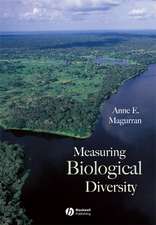The Evolution of the Genome
Editat de T. Ryan Gregoryen Limba Engleză Hardback – 21 ian 2005
The Evolution of the Genome will serve as a critical resource for graduate students, postdoctoral fellows, and established scientists alike who are interested in the issue of genome evolution in the broadest sense.
- Provides detailed, clearly written chapters authored by leading researchers in their respective fields
- Presents a much-needed overview of the historical and theoretical context of the various areas of genomic study
- Creates important links between topics in order to promote integration across subdisciplines, including descriptions of how each subject is actually studied
- Provides information specifically designed to be accessible to established researchers, postdoctoral fellows, and graduate students alike
Preț: 434.37 lei
Preț vechi: 552.70 lei
-21% Nou
Puncte Express: 652
Preț estimativ în valută:
83.14€ • 89.74$ • 69.71£
83.14€ • 89.74$ • 69.71£
Carte tipărită la comandă
Livrare economică 12-26 aprilie
Preluare comenzi: 021 569.72.76
Specificații
ISBN-13: 9780123014634
ISBN-10: 0123014638
Pagini: 768
Ilustrații: Approx. 100 illustrations
Dimensiuni: 152 x 229 x 32 mm
Greutate: 1.03 kg
Editura: ELSEVIER SCIENCE
ISBN-10: 0123014638
Pagini: 768
Ilustrații: Approx. 100 illustrations
Dimensiuni: 152 x 229 x 32 mm
Greutate: 1.03 kg
Editura: ELSEVIER SCIENCE
Public țintă
Graduate students and researchers interested in genomics and evolutionary biology.Cuprins
1. Genome Size Evolution in Animals
2. Genome Size Evolution in Plants
3. Transposable Elements
4. B Chromosomes
5. Small-Scale Gene Duplications
6. Large-Scale Gene and Ancient Genome Duplications
7. Polyploidy in Plants
8. Polyploidy in Animals
9. Comparative Genomics in Eukaryotes
10. Comparative Genomics in Prokaryotes
11. Macroevolution and the Genome
2. Genome Size Evolution in Plants
3. Transposable Elements
4. B Chromosomes
5. Small-Scale Gene Duplications
6. Large-Scale Gene and Ancient Genome Duplications
7. Polyploidy in Plants
8. Polyploidy in Animals
9. Comparative Genomics in Eukaryotes
10. Comparative Genomics in Prokaryotes
11. Macroevolution and the Genome
Recenzii
"Gregory provides an impressive overview of the key areas in genome biology, such as the evolution of genome size in animals and plants, polyploidy, the evolution of genomic parasites, and comparative genomics in eukaryotes and prokaryotes as well...the reading “flows in a very enjoyable way. Gregory and his sixteen co-authors ask endless questions on large-scale evolutionary phenomena – and they answer them all: How common is polyploidy in plants, and how is it linked with animals, i.e. with attacking herbivores? What are “B Chromosomes, how widely are they distributed and where are they derived from? How did genomes originate? What is a procaryotic species? And so forth. In a word: Wherever one opens this well written book, he will read it with great pleasure." --Weanée Kimblewood in LAB TIMES
"The Evolution of the Genome provides a much needed overview of genmoic study through clear, detailed, expert-authored discussions of the key areas in genome biology." --BIOWORLD, 2006
"The Evolution of the Genome by Ryan Gregory and his co-authors is one of the most exciting books on large-scale evolutionary phenomena I have read in the past decade." --Robert L. Carroll, Redpath Museum, McGill University
"Availability of complete genomic sequences has begun to revolutionize many areas within and even outside Biology. This book provides the essential grammar to students and experts alike toward understanding the language of genomes." --Juergen Brosius, University of Munster, Germany
"A very useful book for my evolutionary genetics classes." --Leo W. Beukeboom, University of Groningen, The Netherlands
"Ryan Gregory sees the genome as a distinct level of biological organization. To Gregory and his collaborators in The Evolution of the Genome, the genome has its own internal structures and interactions among its parts. This is a dynamic way of looking at the genome, and one that suggests solutions to many problems--such as why some kinds of organisms have much larger genomes than others. In recognizing the hierarchical organization of the genome itself, Gregory has pioneered the analysis of how the genome fits into the broader aspects of biological organization and evolution. The Evolution of the Genome is an indispensable source on current understanding of genomic evolution." --Niles Eldredge, The American Museum of Natural History, New York, New York
"Gregory has arranged the chapters in a logical sequence, to facillitate a reading straight-through and while maintaining a loose association between them, each contribution is reasonably self-contained, to enable brief consultations...The chapters contain extensive references to guide the reader to further research. There are adequate tables, graphs, plots and illustrative matter to enrich the text. This book is recommended for academic collections supporting research programs in genetics, bioscience, microbiology and the like. This book will appeal to graduate students, looking for grounding in this area and to scientists exploring related research." --Peggy Dominy in E-STREAMS
"The Evolution of the Genome provides a much needed overview of genmoic study through clear, detailed, expert-authored discussions of the key areas in genome biology." --BIOWORLD, 2006
"The Evolution of the Genome by Ryan Gregory and his co-authors is one of the most exciting books on large-scale evolutionary phenomena I have read in the past decade." --Robert L. Carroll, Redpath Museum, McGill University
"Availability of complete genomic sequences has begun to revolutionize many areas within and even outside Biology. This book provides the essential grammar to students and experts alike toward understanding the language of genomes." --Juergen Brosius, University of Munster, Germany
"A very useful book for my evolutionary genetics classes." --Leo W. Beukeboom, University of Groningen, The Netherlands
"Ryan Gregory sees the genome as a distinct level of biological organization. To Gregory and his collaborators in The Evolution of the Genome, the genome has its own internal structures and interactions among its parts. This is a dynamic way of looking at the genome, and one that suggests solutions to many problems--such as why some kinds of organisms have much larger genomes than others. In recognizing the hierarchical organization of the genome itself, Gregory has pioneered the analysis of how the genome fits into the broader aspects of biological organization and evolution. The Evolution of the Genome is an indispensable source on current understanding of genomic evolution." --Niles Eldredge, The American Museum of Natural History, New York, New York
"Gregory has arranged the chapters in a logical sequence, to facillitate a reading straight-through and while maintaining a loose association between them, each contribution is reasonably self-contained, to enable brief consultations...The chapters contain extensive references to guide the reader to further research. There are adequate tables, graphs, plots and illustrative matter to enrich the text. This book is recommended for academic collections supporting research programs in genetics, bioscience, microbiology and the like. This book will appeal to graduate students, looking for grounding in this area and to scientists exploring related research." --Peggy Dominy in E-STREAMS










